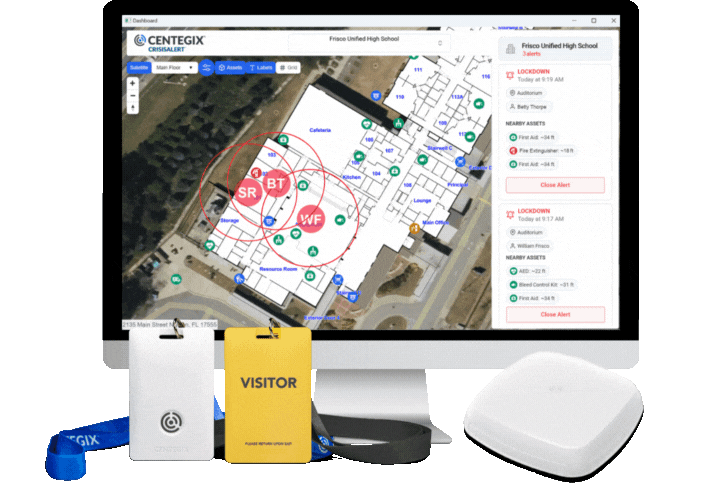Healthcare workers are front-line workers. Day in and day out, their profession requires them to interact with people who are sick, vulnerable, and potentially mentally unstable. In a workplace where crises may erupt at any moment, de-escalation is critical. Healthcare workers need access to solutions that allow them to diffuse frightening and potentially violent situations before they spin out of control. A workplace violence safety plan that gives providers access to a discreet way to call for help can mean the difference between a tense situation and one that ends in physical harm to a caregiver. Particularly in mental healthcare settings, a healthcare safety plan that takes concrete steps to prevent workplace violence creates a culture of safety that protects staff and patients alike.
Healthcare Workers are Vulnerable
Managing patient complaints and dissatisfaction is unpleasant but unavoidable in healthcare settings. Despite best efforts, situations occur in which patients feel compelled to voice their displeasure and concerns. In some instances, patients’ emotions escalate. They may become aggressive, hostile, or violent. In these instances, healthcare providers are called upon to skillfully de-escalate the situation, the first step in mitigating the risk of violence. This is a very tall order, but an effective workplace violence safety plan can assist in the process of de-escalation and offer support to vulnerable employees by rallying staff to their location. Caregivers experience aggressive behavior at alarming rates. One study found that, in instances of workplace violence, patients were the aggressors 46.7% of the time. 64.3% of workers assaulted were nurses, and younger female nurses were particularly targeted. As these statistics reflect, caregiving professionals can be perceived as weak; they are often wrongfully used as targets for patients’ anger. These nurses cannot change their demographic profile, so they need access to concrete solutions that assist in de-escalating potentially dangerous situations. The medical environment creates high levels of stress for both patients and nurses; combined with fear and illness—the two major contributors to patient stress—tensions often run high. Experienced caregivers recognize the signs of patient agitation. These include:
- tightened jaw
- stiff posture
- fidgeting
- pacing
- clenched fists
- raised voice
- irrational demands
Other factors–the very conditions for which patients are receiving treatment–also play a role in whether an individual will become violent. These include biological factors such as irregular brain development, neurodegenerative conditions, gene mutations, hormone imbalances, medication side effects, processing disorders, and medical conditions. A variety of psychological factors, consisting mostly of mental health disorders, can also contribute to patient aggression. A patient’s background can also be an important determiner of whether they will become violent. Caregivers’ words or actions may, for example, unintentionally trigger a patient who experienced neglect or abuse as a child. For any of these reasons, patients’ fear, anxiety, and temperament may manifest as physically or psychologically violent acts toward caregivers. Hospitals and other settings should institute healthcare safety plans that protect staff from these forms of aggression. 
A Healthcare Safety Plan is Instrumental in De-escalating Workplace Violence
According to crisis prevention experts, de-escalation requires a special set of skills that caregivers can learn. Training in these skills is an important element of an effective healthcare safety plan. The first of these is empathic listening, which is a form of communication that emphasizes the following five elements:
- Undivided attention. Validate the patient’s assertions and listen with the entire body.
- Nonjudgement. Use neutral language, tone, and body language.
- Focus on feelings. Elicit communication by responding directly to the feelings expressed.
- Allow silence. Do not fill the space with words; let patients speak.
- Clarify messages. Ask questions to clarify the patient’s assertions.
These de-escalation techniques, when used skillfully, can diffuse a tense situation so that further intervention becomes unnecessary. Crisis prevention experts are careful to remind caregivers to avoid confrontation when weapons or the threat of weapons is present, bodily harm is threatened, or personal insults and abusive language are used. Caregivers should trust their instincts. When they have a gut feeling that they are in danger, they should retreat. A workplace violence safety plan should include both trainings in de-escalation techniques and tools that enable caregivers to call for help discreetly and quickly. This combination of tools can diffuse tense situations as well as keep caregivers physically safe in times when violence erupts.
Workplace Violence Threatens Mental Healthcare Providers

Healthcare safety plan
A common perception in American culture is that mental illness and violence are inextricably linked. This creates a harsh stigma for patients and, at times, an uncomfortable environment for those who care for these patients. Unfortunately, this perceived link between mental illness and violence carries serious consequences for psychiatric patients: they often experience further discrimination and a sense of isolation from society. Many patients in this situation present to emergency departments each year, and psychiatrists and psychiatric nurses are often called upon to assess and treat them. These caregivers have a five to 48 percent chance of experiencing a physical assault by a patient during their career. 40 to 50 percent of psychiatry residents will be physically attacked by a patient during their four-year training program. The stakes are high for mental healthcare providers. Mental health care providers call upon de-escalation tactics to communicate during potentially violent incidents. These providers know that most communication during a crisis is nonverbal:
- 55% body language
- 38% tone of voice
- 7% spoken words
Expert caregivers can certainly mitigate the factors that result in violent altercations in mental healthcare settings. But in some instances, a patient’s aggression cannot be diffused with de-escalation tactics. In these cases, a workplace violence safety plan that includes a method for requesting help from designated staff members in a time of crisis is necessary.
CENTEGIX CrisisAlert: a Critical Element of Your Healthcare Safety Plan
A workplace violence safety plan that prioritizes de-escalation protects the physical and mental well-being of caregivers. When nurses or other providers face patients who are confrontational or experiencing mental health care crises, they need access to quick, discreetly alerted assistance. With the CENTEGIX CrisisAlert system, providers can summon help even as they continue engaging with patients using de-escalation communication techniques. Rather than instigating a department-wide alert, individual caregivers can work to calm patients as other staff members arrive to provide support. A wearable emergency button is a practical solution that facilitates both de-escalation and the physical protection of employees. CENTEGIX CrisisAlert helps create safe communities. Caregivers’ confidence that they can summon help quickly and discreetly from anywhere on campus promotes a culture of safety. The CENTEGIX system is specifically designed to fit into workplace violence safety plans that emphasize de-escalation and prevention of violence. CENTEGIX CrisisAlert works to ensure both patient and caregiver safety. CENTEGIX is the leader in incident response solutions. Our CrisisAlert platform is the fastest and easiest way for staff to call for help in any emergency, from the everyday to the extreme. CENTEGIX creates safer spaces by innovating technology to empower and protect people, and leaders nationwide trust our safety solutions to provide peace of mind. To learn more about CENTEGIX, visit www.centegix.com.









